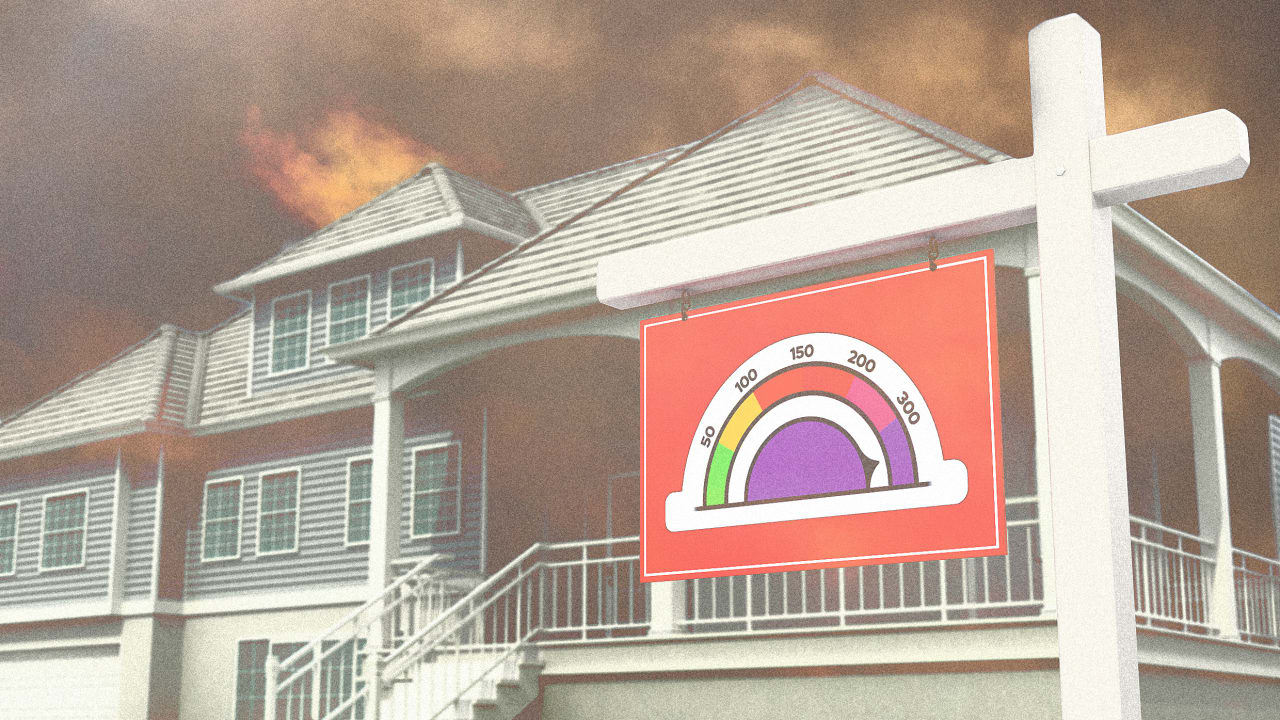Looking for a new home? Redfin will now show you air quality data for any property listing
When you look to buy or rent a home, you might scour real estate listings for details about nearby schools, transit access, or even flood risk. Now, Redfin is giving customers another data point, with information on the air quality around a property. Redfin announced this week that it’s now publishing Air Factor data from First Street, a climate-risk-data provider. A property’s listing on Redfin includes tabs near the top of the page that offer specifics on home details, schools, and climate. Under the “climate” tab, there’s information about a property’s flood, fire, heat, and wind risks, and now data on air quality. Air quality can vary based on different environmental factors, such as wildfire smoke, vehicle exhaust, and industrial emissions, among others. And air quality is getting worse: Between 2000 and 2021, the number of poor air quality days in the Western U.S. increased by as much as 477%, according to a First Street analysis of Environmental Protection Agency (EPA) data. But it’s not only areas at risk of wildfires that can be affected. In the summer of 2023, wildfire smoke from Canada blanketed the East Coast of the U.S., turning the skies an eerie orange and filling the air with harmful particulate matter that sent the air quality index in New York City and beyond to hazardous levels. On a Redfin property listing, viewers can now see the air quality risk of a region, based on the number of days when the Air Quality Index—which ranges from 0 to 500, with the risk increasing as the number goes up—topped 100. The property page also offers insights on how the air quality could change over time; on one listing in Lower Manhattan, for example, this feature declared, “Over the next 30 years, this area will experience a 40% increase in the number of poor air quality days, i.e. where the Air Quality Index exceeds 100.” First Street’s data looks at two common pollutants that affect air quality: PM2.5, or particulate matter that measures 2.5 micrometers or less, which often comes from wildfire smoke; and ozone (O3), which is the main component of “smog” and occurs when pollutants react with heat and sunlight. The Air Factor reading on Redfin takes into account air quality threats from wildfires as well as man-made pollution like car emissions. “Redfin wants to ensure that every single person searching for a home has the information they need to understand climate risks,” Ariel Dos Santos, Redfin senior vice president of product and design, said in a statement. “Air pollution is an important consideration as poor air quality becomes more frequent due to climate threats, such as wildfire smoke.” People may already be taking air quality into consideration when it comes to where they live. About one million more people moved out of, rather than into, areas with high air quality risk in 2021-2022, according to a Redfin report out this week. The inverse was also true: Metros with better air quality saw one million more people move in. Price may also be a factor, though, as Redfin found that metros with a high risk for poor air quality also came with home prices about 65% higher than those in low-risk areas. Though Americans have largely continued to move to places with high climate risks, that may change as the effects of climate change worsen. Features that show things like flood and wildfire risk are already popular on property listings, and a recent survey from Forbes Home found that 30% of Americans cite climate change and its accompanying worsening disasters as a motivator for moving in 2024. Air quality may not seem as detrimental as a flood or fire destroying your home, but it can come with serious health impacts, including increased risks of respiratory infections, stroke, lung cancer, heart disease, even death. A 2020 report found that air pollution is estimated to have caused some 8.8 million more premature deaths worldwide in 2015 than tobacco smoking, HIV/AIDS, malaria, and all forms of violence. Redfin says that with this added feature, it is the only brokerage to provide air quality risk data at the property level.

When you look to buy or rent a home, you might scour real estate listings for details about nearby schools, transit access, or even flood risk. Now, Redfin is giving customers another data point, with information on the air quality around a property.
Redfin announced this week that it’s now publishing Air Factor data from First Street, a climate-risk-data provider. A property’s listing on Redfin includes tabs near the top of the page that offer specifics on home details, schools, and climate. Under the “climate” tab, there’s information about a property’s flood, fire, heat, and wind risks, and now data on air quality.
Air quality can vary based on different environmental factors, such as wildfire smoke, vehicle exhaust, and industrial emissions, among others. And air quality is getting worse: Between 2000 and 2021, the number of poor air quality days in the Western U.S. increased by as much as 477%, according to a First Street analysis of Environmental Protection Agency (EPA) data. But it’s not only areas at risk of wildfires that can be affected. In the summer of 2023, wildfire smoke from Canada blanketed the East Coast of the U.S., turning the skies an eerie orange and filling the air with harmful particulate matter that sent the air quality index in New York City and beyond to hazardous levels.
On a Redfin property listing, viewers can now see the air quality risk of a region, based on the number of days when the Air Quality Index—which ranges from 0 to 500, with the risk increasing as the number goes up—topped 100. The property page also offers insights on how the air quality could change over time; on one listing in Lower Manhattan, for example, this feature declared, “Over the next 30 years, this area will experience a 40% increase in the number of poor air quality days, i.e. where the Air Quality Index exceeds 100.”
First Street’s data looks at two common pollutants that affect air quality: PM2.5, or particulate matter that measures 2.5 micrometers or less, which often comes from wildfire smoke; and ozone (O3), which is the main component of “smog” and occurs when pollutants react with heat and sunlight. The Air Factor reading on Redfin takes into account air quality threats from wildfires as well as man-made pollution like car emissions.
“Redfin wants to ensure that every single person searching for a home has the information they need to understand climate risks,” Ariel Dos Santos, Redfin senior vice president of product and design, said in a statement. “Air pollution is an important consideration as poor air quality becomes more frequent due to climate threats, such as wildfire smoke.”
People may already be taking air quality into consideration when it comes to where they live. About one million more people moved out of, rather than into, areas with high air quality risk in 2021-2022, according to a Redfin report out this week. The inverse was also true: Metros with better air quality saw one million more people move in. Price may also be a factor, though, as Redfin found that metros with a high risk for poor air quality also came with home prices about 65% higher than those in low-risk areas.
Though Americans have largely continued to move to places with high climate risks, that may change as the effects of climate change worsen. Features that show things like flood and wildfire risk are already popular on property listings, and a recent survey from Forbes Home found that 30% of Americans cite climate change and its accompanying worsening disasters as a motivator for moving in 2024.
Air quality may not seem as detrimental as a flood or fire destroying your home, but it can come with serious health impacts, including increased risks of respiratory infections, stroke, lung cancer, heart disease, even death. A 2020 report found that air pollution is estimated to have caused some 8.8 million more premature deaths worldwide in 2015 than tobacco smoking, HIV/AIDS, malaria, and all forms of violence. Redfin says that with this added feature, it is the only brokerage to provide air quality risk data at the property level.






















